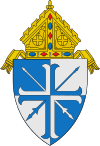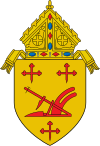Joseph H. Albers
Appollonaire University |
|---|

Joseph H. Albers
Albers received a Silver Star for his service as a
Biography
Early life
Joseph Albers was born on March 18, 1891, in
Priesthood
Albers was ordained a
After the outbreak of World War I, Albers join the
After being discharged from the Army in 1919, Albers returned to Cincinnati. He soon became assistant chancellor and assistant to the archbishop. In 1925, Alberts was appointed
Auxiliary Bishop of Cincinnati
On December 16, 1929,
Bishop of Lansing
On May 26, 1937, Pope Pius XI appointed Alberts as the first
During Albers's episcopacy, the diocese built 38 parishes, 42 elementary schools and two high schools. This earned Albers the appellation "The Builder".
Retirement and legacy
On October 7, 1964, Pope Paul VI accepted Albers's early retirement as bishop of the Diocese of Lansing due to bad health. He was succeeded by Bishop Alexander M. Zaleski.[2][12] Joseph Albers died in Lansing on December 1, 1965, at age 74.[12] He was interred at St. Joseph's Catholic Cemetery in Lansing.[13]
The
References
- Good Samaritan School of Nursing, The Victorian. Cincinnati, Ohio: U.S. GenWeb project. 1930. Retrieved September 16, 2012.
- ^ a b c d e Faith Magazine, History of Lansing diocese. Archived July 10, 2011, at the Wayback Machine
- ^ a b c d "Bishop Joseph Henry Albers [Catholic-Hierarchy]". www.catholic-hierarchy.org. Retrieved 2022-07-08.
- ^ ISSN 0362-4331. Retrieved 2022-07-08.
- ^ Parish Archives, The History of Old St. Mary Church (from the 1942 Anniversary Edition). Archived September 30, 2008, at the Wayback Machine
- ^ "Meadovue: History of the English Inn". Eaton Rapids, Michigan: The English Inn. Retrieved May 20, 2021.
- ^ "MI State Historic Preservation Objects". 2011-06-06. Archived from the original on 6 June 2011. Retrieved 2022-07-08.
- ^ Msgr. George Michalek. "History of the bishops of Lansing". Archdiocese of Lansing home page and history. Archdiocese of Lansing, Michigan. Archived from the original on 2007-09-17. Retrieved 2007-11-30.
- ^ "Diocese of Lansing | Office of the Bishop". Archived from the original on September 17, 2007. Retrieved November 30, 2007.
- ^ "Education for Living – Faith for Life".
- ^ "Catholic Weekly / Catholic Times". Archived from the original on 2003-12-26.
- ^ a b Archdiocese of Lansing home page and history Archived September 17, 2007, at the Wayback Machine
- ^ "St. Joseph Catholic Cemetery Headstones, Lansing, Ingham County, Michigan".
- ^ Knights of Columbus, #4090, Bishop Joseph H. Albers Council. Archived May 9, 2008, at the Wayback Machine
- ^ St. Joseph Catholic Church, Battle Creek, Early parish history.
- ^ "Bishop Joseph H. Albers Trust Fund". Diocese of Lansing. Retrieved May 20, 2021.
- ^ "Notre Dame Archives Inventory: PCO".
External links
- "Photo of Right Reverend Joseph H. Albers, D.D". Good Samaritan School of Nursing, The Victorian, Cincinnati, Ohio. U.S. GenWeb project. 1930.
- Catholic Telegraph Photography Project, photograph -- a scene from the life of Joseph H. Albers, 1934. Historical photos from the files of The Catholic Telegraph, the official newspaper of the Archdiocese of Cincinnati.
- State of Michigan statement of historical significance, Meadowvue Estate, Reuter, Irving and Janet, House 728 South Michigan Road, Eaton Rapids - Eaton County.
- Joseph H. Albers headstone
- Priests and Bishops monument, St. Joseph Cemetery, Lansing, Michigan




